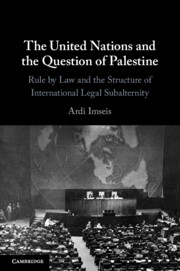 The United Nations and the Question of Palestine
The United Nations and the Question of Palestine Book contents
- The United Nations and the Question of Palestine
- The United Nations and the Question of Palestine
- Copyright page
- Dedication
- Contents
- Maps
- Foreword
- Preface
- Acknowledgements
- Table of Cases
- Table of Treaties and International Instruments
- Abbreviations
- 1 Introduction
- 2 The Interwar Period
- 3 1947: The UN Plan of Partition for Palestine
- 4 1948 and After: The UN and the Palestinian Refugees
- 5 1967 and After: The UN and the Occupied Palestinian Territory
- 6 2011 and After: Membership of Palestine in the UN
- 7 Conclusion
- Postscript
- Index
4 - 1948 and After: The UN and the Palestinian Refugees
Published online by Cambridge University Press: 16 November 2023
- The United Nations and the Question of Palestine
- The United Nations and the Question of Palestine
- Copyright page
- Dedication
- Contents
- Maps
- Foreword
- Preface
- Acknowledgements
- Table of Cases
- Table of Treaties and International Instruments
- Abbreviations
- 1 Introduction
- 2 The Interwar Period
- 3 1947: The UN Plan of Partition for Palestine
- 4 1948 and After: The UN and the Palestinian Refugees
- 5 1967 and After: The UN and the Occupied Palestinian Territory
- 6 2011 and After: Membership of Palestine in the UN
- 7 Conclusion
- Postscript
- Index
Summary
This chapter critically examines the distinctive institutional and normative regime created by the UN for the Palestinian refugees in the immediate aftermath of the Nakba in the form of the United Nations Conciliation Commission for Palestine and the United Nations Relief and Works Agency for Palestine Refugees in the Near East. It juxtaposes that regime against the international institutional and normative regime applicable to all other refugees in the world, as administered by the United Nations High Commissioner for Refugees. The special regime for Palestinian refugees is widely regarded as reflective of the UN’s unique responsibility for their plight. Yet, a critical examination of the UN record on the early history, mandate, and regulatory framework underpinning this regime reveals that it was never intended to give effect to Palestinian refugee rights as established under prevailing international law, including as affirmed by the UN itself. The resulting ‘protection gap’ that has consequently emerged for Palestinian refugees, marked by uneven and confused state practice concerning their plight as well as ongoing gender discrimination against them by the UN, is demonstrative of the Organization’s role in the maintenance of Palestinian legal subalternity on the international plane.
Keywords
- Type
- Chapter
- Information
- The United Nations and the Question of PalestineRule by Law and the Structure of International Legal Subalternity, pp. 110 - 171Publisher: Cambridge University PressPrint publication year: 2023
